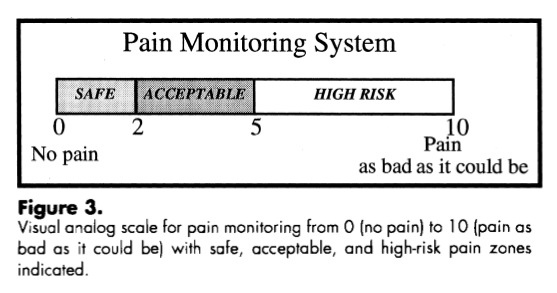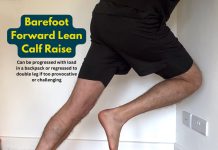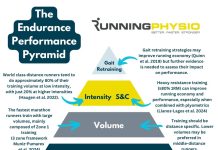Our articles are not designed to replace medical advice. If you have an injury we recommend seeing a qualified health professional. To book an appointment with Tom Goom (AKA ‘The Running Physio’) visit our clinic page. We offer both in-person assessments and online consultations.
Pain is a complex thing. It can stop us in our tracks or it can tell us when we’ve had a good workout. It can vary greatly from severe and sharp to dull and aching and what’s really odd about it is it’s a rather blunt tool for telling us what’s wrong. Many people think pain means you’ve damaged something but this often isn’t the case. In fact, pain and tissue damage are very poorly correlated. Think about cramp, severely painful but no tissue damage or a migraine, high levels of pain but no trauma. So if pain is a blunt tool should we really use it to stop us from exercising?…
Let’s first start with a little word of warning I’m not giving people the green light to keep running through pain! If you have persistent pain when running get it checked out. What I want to do is add some clarity for people to know what to do if it hurts when they run but I’d still recommend discussing this with a qualified health professional. Here are a few things to consider;
- Signs of serious injury – swelling, severe pain, giving way or locking of a joint and bony tenderness are all signs of injury that are important to get checked out. I’d also add pins and needles or numbness to this list and pains that refer from one area to another (e.g. back pain with leg pain). These aren’t things to run through!
- Can you change it? – rather than simply ploughing on in pain see if you can change it. Slow down for a while, reduce your stride length, change the running surface or break up your running with walking or side-stepping for a little while. This will often allow a niggle to settle as you run. You might also try taping or a change of footwear and see how your symptoms respond.
-
- Pain response – it’s useful to think of pain in its different stages
- Immediate response – how is it as you run? Can you run through it without it affecting how you run? Does it stay the same or settle as you run or get progressively worse? Research by Silbernagel et al. (2007) used pain severity as a guide for patients with Achilles tendinopathy (of at least 2 month duration). They suggest pain during exercise should not reach more than 5 out of 10 (on a scale where 0 is no pain and 10 is the worse pain imaginable). This is based on earlier work on patellofemoral pain by Thommeé (1997) who created the scale below. Personally I prefer airing on the side of caution and ensuring pain stays mild (e.g. 3 or less out of 10).
- Next 24-48 hours – some tissues have a ‘latent response’ to exercise. That is they may not react immediately but instead, pain develops over 24-48 hours. Tendons are said to behave in this way. I’ve been trying to return to running after hamstring tendinopathy. I ran for 4 miles with pain at 3-4 out of 10. It felt easier as I ran. Sadly it was sore for 5 days after – a sign I’d done too much or it’s too soon to run. If you are attempting a graded return to running or having issues with pain, monitor your symptoms for about 2 days after running. Silbernagel et al. Include this in their recommendation – pain was allowed to reach 5 out of 10 after exercise but should have subsided by the following morning. Pain and stiffness were not allowed to increase from week to week…which brings us to the medium and long term response…
- Medium and Long term response – with pain or injury it’s a good idea to keep an eye on the bigger picture. Essentially you’re asking yourself ‘is this getting better?’ If you’re continuing to run with pain but your symptoms simply aren’t improving, or are getting worse you have to wonder whether a different approach is necessary. We all get transient pains when we run that often disappear quickly – persistent pains should act as a warning that something isn’t quite right and might benefit from being looked at by a health professional.
- Pain response – it’s useful to think of pain in its different stages

- Tissue involved and stage of healing – there are a few stages of injuries where running really should be avoided. Ideally, your Physio should guide you with this if you’re injured. If there is any suggestion of stress fracture then running should be avoided until advised safe to do so. The acute stage post-injury is also a time where rest from running is wise. Reactive tendinopathy (when the tendon swells due to an acute increase in loading) is also likely to be aggravated by running initially. More chronic tendinopathy, where there has been pain for some time, is less likely to be aggravated by running. It should be noted that the recommendations of Silbernagel et al. were based on patients with at least 2 months of Achilles tendinopathy. It’s likely these patients were out of the reactive stage. Coming back to my hamstring tendinopathy example, it’s still within its reactive stage which is probably why it was sore for days after running. On reflection I’ve realised I’ve tried to return to running too quickly and will cross-train for a little longer instead. Have a think about what tissue might be causing your pain. Is it just a little muscle tightness or a stiff joint? If unsure and the pain persists get a Physio or health professional to assess it for you.
Wisdom from the Twittersphere;
We’re lucky to have some exceptional clinicians and experienced runners on Twitter who can share their knowledge with us. I’ve summarised people’s points from our discussion which can be read in full here.
@GregLehman – Physio, Strength and Conditioning Specialist and creator of the truly awesome http://thebodymechanic.ca had some great advice (although he did talk about bears a lot!);
“Sometimes [you can run through pain] especially if you can modify it. I think it’s good to poke the bear to increase pain threshold…pain threshold is different from injury threshold. Running can be rehab… Fear can increase our pain. We need graded motor exposure to pain during running.”
He went on to say you’d aim for 4 out of 10 for pain and avoid “wind up sensitization” the next day. Wise words and his summary had me in stitches,
“Must follow graded exposure. Poke the bear not hump the sh*t out of it!”
Although we had a laugh with this discussion on Twitter I have to say the standard and depth in Greg’s work is amazing. Make sure you check out his site and follow him on Twitter. He’ll be writing an article on this topic himself for a triathlon magazine article due to be published in May so keep an eye out for that.
Following on from this physio and running injury specialist John Foster (@physiodynamics) added,
“We use the 3/10 VAS within 24 hours rule. Any pain greater means the bear was poked too hard!”
@Fizziowizzio is an experienced Physio with a special interest in tendinopathy, he added a nice summary too,
“Define acceptable level [of pain], tissue for consideration, healing stage, post activity reaction” and if best to keep going in some form due to “psychological impact, fitness, graded stress and healing stimulation.”
No discussion of pain and running could be complete without including some ultramarathon runners. These guys regularly run through pain…
Ultra runner @Bryanwe is definitely no stranger to pain. He recently completed in the Thames Path 100, an ultra race covering 103 miles and over 24 hours of continuous running. He’s written a blog about it here. Bryan had hip pain from mile 12 and continued with it for 91 miles. Yes, 91. I saw Bryan this week and he’s been struggling to walk since. I assessed him and my conclusion was that his hips and pelvis were sore due to carrying balls of steel around all day! He shared his views,
“Well I think it is relative to the event, you can’t do 100 miles and expect it to not hurt. I would say a lot of ultra runners run through pain. Also the other thought is do you know what is causing the pain, i.e. are your feet blistered. I probably wouldn’t run through an unexpected pain like abdominal or chest pain but 100 miles and your legs hurt is expected.
“One ultra I did someone asked if I had other races coming up, when I said no he said good so you can “do yourself in” on this one!”
One thing I would say here is that running through pain in a race is a different decision from doing so in training. This is summed up nicely by @johnnyultra “the old cliché that pain’s temporary is true. It will go away quickly but if u give up the feeling of failing stays longer”. Again though it’s a personal decision and if there is a risk of long term problems then sometimes it’s better not to finish than hobble over the line and not run again for months.
In summary if you have pain when running we recommend seeking the advice of a qualified health professional. Ultimately it is your decision whether to run or rest but you should be aware of the risks – running with pain can aggravate injuries and lead to a lasting flare up in symptoms. In clinic we often suggest to patients that they can continue to run if symptoms are mild during and settle quickly afterwards but this is patient and injury specific. For example, with bone stress injuries and stress fractures we need to ensure adequate healing has taken place before return to running and any exercise should be pain free both during and after.
Limitations
I’m not aware of much research in this field. What there is by Silbernagel et al. has its limitations. They compared 2 groups – one that continued sports (including running) and one that didn’t. Both groups completed an Achilles tendon rehab programme and reported significant improvement with no negative effects seen from continuing sport. However, the study only included one specific injury and had just 38 patients. They also didn’t define the stage of the tendinopathy so it’s hard to conclude at what point you might re-introduce running.
Further research is needed in this field covering a breadth of running injuries and examining long term effects. Our advice is based on theory and experience rather than a well-developed evidence base.
Closing thought: sometimes you may choose to run through pain. This isn’t always a bad idea but give it some thought and seek advice from a health professional rather than ploughing on regardless. Ask yourself why you’re getting the pain and what you can do to make it better. And, as ever on RunningPhysio, if in doubt, get it checked out.
Further reading:
- Deciding whether to run or rest
- Returning to running after injury
- Pain and the brain
- Back pain and pacing










Awesome! & Greg’s ‘Bear’ comments were certainly priceless! I followed some of them through the other day.. it was hilarious!
Question though.. Last summer, I was running approx 6 miles (easy pace) when at about 3 miles I ran over a curb, as in stepped up from the road to grass verge (must have misjudged) & my ankle went over & gave way completely.. It stopped me in my tracks & had I been on my own, I most certainly would have stopped & walked home, or rang the wife for a lift lol.. the pain would have been about 7 or 8 out of 10.
I was with another bunch of runners though (local running club) & they were all a lot more experienced than me, so after 30 seconds or so of talking to me & seeing if I could put weight on it, they pretty much all agreed that the best thing for it (if my pain allowed me) was to continue running..
They kept asking to see if I was ok & I continued & finished the last 3 miles (all be it with a slightly swollen ankle)
Did I do the right thing? & was it the right advice from them? My gut tells me yes it was, although I did have a hell of a bruise & swelling for a good while..
Hi Tom, what a great blog, and just what I’ve been battling with too. Your advice is great and spot on. I hope you don’t mind me linking it to this week’s blog where pain has been a bit of an issue. I came home from a run shortened by hip pain and your blog was perfect. Thanks again! @NBSue
Great article Tom,
thats a doubt many of us have!
Thanks for sharing your thoughts and research on the topic.
Claudio
Wise insight, Tom. The decision to slow down to treat an injury or be a tough guy/gal with a running injury is rarely an easy one. Your advice for your readers is great advice to make those decisions easier.
Thanks for sharing!
[…] http://www.running-physio.com/running-pain/ […]
Comments are closed.